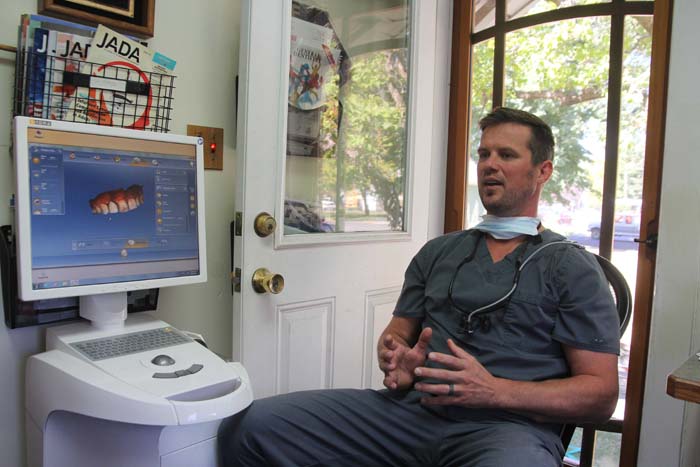Dentist sees damage from sugar
Published 7:30 am Wednesday, November 30, 2016

- La Grande dentist Dr. Eli Mayes said he’s seen the impact of drugs or lack of care on teeth. However, the horrific sights he witnessed practicing dentistry in Alaska still set an unfortunate standard.(Cherise Kaechele/The Observer)
As a dentist, Dr. Eli Mayes said he’s seen the impact of drugs or lack of care on teeth. However, it pales in comparison to what he witnessed practicing dentistry in Alaska.
“I’ve seen meth mouth here,” Mayes said. “I haven’t seen anything compared to what I saw up there from just sugar.”
Born and raised in Union, Mayes, who owns Eli Mayes Dental, and his family moved to La Grande when he was in the eighth grade. His father, Jerry, and mother, Suzy, have been involved in area education for years. Suzy is the principal at Central Elementary School, and Jerry retired from his position as principal of Hines Middle School earlier this year.
The educators’ son attended the University of Idaho, and then graduated from the University of Oregon before diving into graduate school at the Virginia Commonwealth University School of Dentistry in Richmond, where he received his Doctor of Dental Surgery degree.
“Right out of dental school, you try to figure out what you’re going to do when you graduate,” Mayes said. “I had a friend tell me about Barrow, Alaska, which is the northernmost point in Alaska, 250 miles north of the Arctic Circle.”
So Mayes accepted a position to practice at a health center in the North Slope town of Barrow, where the medical facilities had living quarters for dentists. He and two other dentists also periodically took care of five other villages. Mayes was mainly responsible for villages such as Kaktovik and Point Lay, which he said was more than 100 miles from Barrow.
Getting from Barrow to the smaller villages required the use of a bush plane.
“It was rare when I went to Barter Island (where Kaktovik is) that I wouldn’t get stuck there,” Mayes said. “There would be a fog that always came in. The plan would be to visit the villages for seven to 10 days, but I’d (usually) be there for 14 days.”
An avid outdoorsman, Mayes said he enjoyed all the spoils the Last Frontier had to offer, highlighted by the sheer vastness of the Brooks Range, salmon fishing and hunting.
One aspect of village life that left Mayes in awe was the whale hunts to feed the villages.
The entire process involved countless aspects: ice-cutting to gain greater access to water, waiting for whales to come up and breathe and the boats’ method of funneling the whales to the hunters. Villagers believing whales would “present themselves” in the channels as a way of saying they were there to feed the Alaskans.
“It was just very religious and very intense,” Mayes said.
But besides the 24 hours of daylight in the summer, which wreaked havoc on Mayes’ schedule and sleep patterns, another aspect Mayes had to get used to was the sugar damage to teeth, especially in the village children.
While it’s common knowledge in the United States that soda is unhealthy, he said parents had no problem letting 2-year-olds drink it instead of water.
“We did a survey (of) the whole North Slope, (and) the average amount per day of pop drunk by each person was six (cans) a day,” Mayes said.
He said it was common to see people of all ages with black teeth or no teeth at all, having been eaten away to where there were just black nubs at the gumline.
“I had 2-year-olds with abscesses everywhere,” he said. “We had to strap (children) down, numb everything and take out all their teeth all the time. It was so common that parents would just drop them off — like no big deal, because that’s normal to have your child’s head strapped down, without general anesthesia, and have their teeth ripped out. That’s horrible.”
Mayes and the other dentists would travel to schools and brush children’s teeth, provide fluoride and apply sealants and do radio broadcasts touting dental hygiene. He said he did start to see a shift when children began telling their parents and grandparents that sugary drinks were bad for their teeth, but he knew it would take more generations for the practice to take hold.
Mayes was there for three years before he returned to Eastern Oregon to start a partnership with Dr. Patrick Nearing, Doctor of Dental Medicine, in 2010. The partnership came about because of a happenstance meeting two years prior with Nearing’s wife on the chairlift at Anthony Lakes while Mayes was visiting home from Alaska.
“Two years later (Nearing called and said), ‘Hey, Eli, I’m looking for an associate, and my wife told me you were a dentist from La Grande.’ I had looked at three or four dental practices in the Northwest, and I was either going to renew (in Alaska) or find a private practice,” Mayes said.






